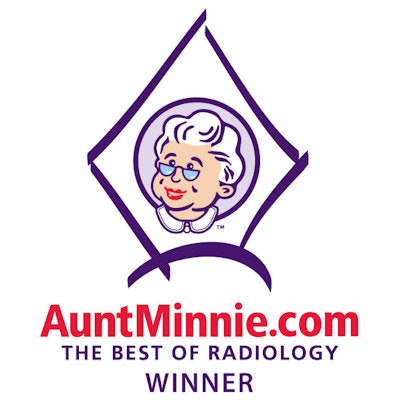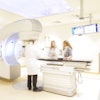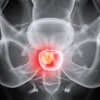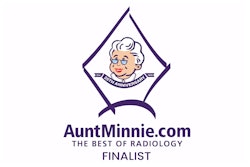The presidential election may have ended last week in the U.S., but votes were still being counted for the 2024 edition of the Minnies.

With 100% of precincts now reporting, we’re finally ready to declare this year’s winners in our annual awards program recognizing excellence in radiology. Once again, we had a top-notch group of finalists, presenting our expert voting panel with some very difficult decisions. For the second year in a row, the voting results were very close in nearly every one of the 15 Minnies categories.
Generative AI was a common theme that resonated with our expert panel, figuring in three different Minnies this year. The voters also zeroed in on the ongoing shortage of radiologists as the Biggest Threat to Radiology.
This year’s awardees include a few previous trophy winners, as well as several first-time recipients. As was the case last year, we’ve also invited each of the Minnies winners to say a few words about their Minnies award. We hope you enjoy our article as well as the opportunity to hear directly from the recipients.
Congratulations to all the winners of the 2024 Minnies awards, and also to the runners-up and the hundreds of candidates who made the semifinalist list and finalist list.
Interested in the history of the Minnies? You can view our comprehensive list of all the Minnies winners over the past 25 years.
Most Influential Radiology Researcher
Minnies 2024 Winner: Erik H. Middlebrooks, MD, Mayo Clinic, Jacksonville, FL
 Erik H. Middlebrooks, MD.
Erik H. Middlebrooks, MD.
This year's Minnies winner for the category Most Influential Radiology Researcher is Erik H. Middlebrooks, MD, of the Mayo Clinic in Jacksonville, FL. Middlebrooks' research interest consists of using ultrahigh-field, 7-tesla MRI to plot brain microstructure and develop surgical treatment of brain tumors, epilepsy, and neurodegenerative and movement disorders such as Parkinson's disease, essential tremor, and dystonia.
Middlebrooks is associate chair of the Mayo Clinic's research and innovation division in its department of radiology, as well as senior editor of the American Journal of Neuroradiology and president of the Southeastern Neuroradiological Society. He earned his medical degree at the University of Alabama School of Medicine and completed a residency in diagnostic radiology at the University of Florida.
He is particularly excited about the growth of ultrahigh field MRI in neuroimaging -- especially since he reads neurodegenerative and movement disorder cases every day, he told AuntMinnie.com.
"We are now witnessing the payoff of decades of dedicated research and development that went into building [ultrahigh-field MRI]," he said. "As it becomes increasingly accessible to patients, we are learning daily about new applications and ways to improve patient outcomes. While the benefits have been clear in areas such as epilepsy and multiple sclerosis, these only hint at the broader potential of 7T MRI. Importantly, we are gaining deeper insights into disease processes themselves, which enhances our ability to diagnose and potentially treat conditions that were previously beyond our reach."
His lab team is currently focused on "implementing advanced techniques, such as parallel transmit, to achieve more consistent image quality and fully harness the power of 7T for every patient," Middlebrooks said.
"Given the extensive array of sequences and techniques employed in clinical imaging, we must address the inherent challenges associated with each," he noted. "Avoiding certain sequences due to difficulties at 7T is not always practical. Over the past few years, we have succeeded in developing robust, high-quality imaging protocols that are effective in approximately 85% of patients, but we strive to raise this to nearly 100%. We also recognize the potential of AI in image acquisition and reconstruction at conventional MRI field strengths, and we believe these techniques can substantially benefit 7T MRI, helping us overcome existing challenges."
AuntMinnie.com · Minnies 2024 - Most Influential Radiology Researcher
Runner up: Perry Pickhardt, MD, University of Wisconsin -- Madison
Most Effective Radiology Educator
Minnies 2024 Winner: Elliot K. Fishman, MD, Johns Hopkins Medicine
 Elliot K. Fishman, MD.
Elliot K. Fishman, MD.
Elliot K. Fishman, MD, has been around the proverbial Minnies block many times. In fact, this year is his record fifth win in the Most Effective Radiology Educator category. He's also been awarded a Minnie five times for Best Educational Mobile App, once for Most Influential Radiology Researcher, and once for Best Radiology Image.
Fishman joined the faculty at Johns Hopkins University in Baltimore in 1981 and is currently a professor of radiology and radiological science, oncology, surgery, and urology as well as director of body CT, principal investigator of the Felix 2.0 AI Project, and a member of the Johns Hopkins Kimmel Cancer Center. Throughout the 1980s, he worked on 3D imaging with Pixar Animation Studios and continues this work with firms such as Microsoft and Nvidia. He founded and runs an educational website called Ctisus (which produces the apps that garnered his five Minnies in the Best Educational Mobile App category). In 2018, Fishman received an endowed professorship from Johns Hopkins.
His research interests span a gamut of topics, from 3D medical visualization, applications of AI in the early detection of cancer, and multidetector computed tomography/CT angiography development to oncologic imaging and Web-based education and training.
But it's the opportunities to contribute to radiology education that Fishman appreciates, noting that for him, what makes being an educator exciting is that educational themes and goals are dynamic rather than static.
"Education is always changing," he told AuntMinnie.com. "In a short time, we've gone from textbooks to the Web and we need to continue to take advantage of these new ways of teaching."
Fishman's current educational foci include the Ctisus website, which offers free, up-to-date information on CT imaging to members in more than 210 countries, and AI in radiology.
"I do believe that AI is the future and through lectures and other content I use it to share my experience with early cancer detection," he told AuntMinnie.com. "I've also been focusing on how ChatGPT can be used for a more personal teaching experience -- it's a unique approach to engaging with our trainees."
Fishman concedes that there are barriers to educational pursuits in the radiology sphere -- not the least of which is pressure on radiologists to generate high relative value units. But these barriers aren't deal-breakers.
"New strategies will be needed to train the next generation of radiologists, and I'm very excited about these new opportunities," he said. "Projects like our work with Microsoft's AI for Good initiative help us learn from others what works in different fields and then translate those learnings to radiology."
AuntMinnie.com · Minnies 2024 - Most Effective Radiology Educator
Runner up: Francis Deng, MD, Johns Hopkins Medicine
Most Effective Radiologic Sciences Educator
Minnies 2024 Winner: Kori Stewart, PhD, Quinnipiac University, Hamden, CT
 Kori Stewart, PhD.
Kori Stewart, PhD.
Kori Stewart, PhD, never set out to become an educator, but she surely has soared as one, winning this year's Minnies award for Most Effective Radiologic Sciences Educator.
A dedicated teacher and radiologic technologist since 2009, Stewart currently serves as associate professor of diagnostic imaging, and program director of radiologic sciences at Quinnipiac University in Connecticut. Speaking with AuntMinnie, she credited one of her mentors, Professor William Hennessy, for his impact in her life, specifically, suggesting one day that she teach a couple of lab classes.
"I thought, 'I'm not a teacher. I'm a radiographer,' " Stewart recalled.
But Hennessy encouraged her.
"Obviously, I accepted his offer, and I taught a couple of [radiologic sciences] labs as an adjunct, and one of the first labs I was asked to teach was a patient care lab," she said. "It was an immediate sense of joy."
She added that she is glad to now be giving back in the classroom in a dedicated way.
"I have an opportunity to impact those students, the future of our profession," she said.
A majority of Stewart's students are typical undergraduates who have just graduated from high school. The program at Quinnipiac is rigorous, Stewart said, essentially a four-year degree's worth of classes condensed into three years.
With students' well-being in mind, Stewart's classes usually begin with a wellness check, "a thumbs up, thumbs in the middle, thumbs down kind of thing," to see how students are doing to help determine the day's lesson approach.
"This is also an opportunity to help students learn about themselves and how to navigate life's challenges," Stewart said. "I'm trying to help them understand that you cannot show up in a clinical environment and give your very best to a patient if you have not first taken care of yourself."
Stewart was appointed to her current teaching role in August 2022 but says achieving her PhD in health informatics and working later at the Society for Imaging Informatics in Medicine (SIIM) has brought her career full circle, so far. Her research focuses on predictive modeling in AI, clinical decision support, medical image processing, clinical problem-solving, and decision-making.
"My aha moment started in the fall of 2015 when I realized that informatics played such a huge role in medical imaging," Stewart said. "I never saw this as a student, but I realized how much crossover there was and so I sprinkle informatics into RS classes that you wouldn't necessarily expect." For example, in patient care courses there is a natural crossover.
To those in the radiological sciences, Stewart encourages them to embrace informatics and AI.
"If we don't embrace informatics, embrace AI, and start getting more involved in that research, ourselves as subject matter experts, we're going to end up sitting on the sideline because AI is here," Stewart added. "It's going to start really being embedded in more things that we do in our workflows and radiology."
Quinnipiac University's radiologic sciences program requires a research project. It's a perfect fit for Stewart who calls herself a "research nerd" and encourages her students to grow their imaging knowledge through research projects that truly interest them.
"A student with a passion for brain injuries ... when they have an opportunity to dive into that more, it also gets them to learn about other areas of imaging," Stewart said.
Stewart's work has led to her current tenure-track appointment.
AuntMinnie.com · Minnies 2024 - Most Effective Radiologic Sciences Educator
Runner-up: Colleen Dempsey, EdD, Thomas Jefferson University, Philadelphia, PA
Most Effective Radiology Administrator/Manager
Minnies 2024 Winner: Dmitry Beyder, CNMT, Barnes-Jewish Hospital / Washington University, St. Louis, MO
 Dmitry Beyder.
Dmitry Beyder.
This year's Most Effective Radiology Administrator/Manager wears multiple hats at Barnes-Jewish Hospital (BJH) and Washington University (WU) in St. Louis, MO.
In his roles as theranostics practice administrator, radiology program manager, and patient transport program manager, "what has been awesome is surrounding myself with really good people and understanding how to work with them and understanding how to see other people's strengths and passion," he shared with AuntMinnie.
Beyder played a key role in launching the radiopharmaceutical therapy (RPT) comprehensive center of excellence at WU, BJH, and Siteman Cancer Center last year. Looking back, he said a family promise led him into healthcare, and whether intentional about it or not, he's been ambitious to better healthcare since coming to the U.S. from Ukraine.
A recent trip to Korle-Bu Teaching Hospital in Ghana has Beyder thinking about what the future holds for the international cancer center. With training as a technologist, clinical provider, and administrative leader, Beyder called the project eye-opening and said he is looking forward to working with the grant provider, the U.S. Department of Energy and project leader, the Society of Nuclear Medicine and Molecular Imaging, on the way forward to "really help the people in West Africa."
Back at home, though, Beyder is rounding through clinical departments, patient transport, and with clinical leaders and application specialists for the different modalities. Above all, "I come to work to take care of our staff and take care of our patients," he said, adding, "It's important to see your patients, to understand what they're going through."
Looking ahead, Beyder said he is now involved in the larger health system work of BJC Health System of St. Louis. The organization which is home to BJH has embarked on a 14-hospital project with the goal to standardize processes, such as accepting patients into the imaging facility.
"I want the patient to walk into a radiology suite, and I want us to be able to scan their armband and for everything to come up automatically in the medical record system, for their name to come up automatically on the scanner, for the contrast I need to inject, and fully automated with some machine learning and AI, to make sure we're doing the right protocol," Beyder said. "We've been working on that."
Another project has Beyder working with health system leaders in radiology, IT, safety, and policy. Workflows, policies, and procedures created will be especially useful as BJC Health merged earlier this year with St. Luke's Health System of Kansas City toward an integrated, academic, and patient-centric Missouri-based health system.
"We're more than 20 hospitals now," Beyder said. "I now have the opportunity on the east side of our system to work with amazing people to make our operations better. A lot of the dreams and goals that I have is I want to make sure we always do the right patient, want to make sure we always do the right protocol, and our technologists work to the top of their scope to provide extraordinary patient care."
His advice to the up-and-coming is to "push," and "don't be uncomfortable moving the cheese, that is integral to make the improvements we need to better healthcare." He added, "I give people the feedback that has been instrumental to me."
AuntMinnie.com · Minnies 2024 - Most Effective Radiology Administrator/Manager
Runner-up: Ashley Darby, University of Mississippi Medical Center and Children's of Mississippi, Jackson, MS



















